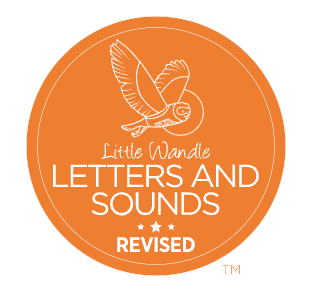Please also see our Intent-Implementation-Impact statement for Phonics and all subjects which can be found under the Curriculum tab in 'Curriculum Statements'
Phonics and Early Reading at Hayfield Cross
At Hayfield Cross the children in Reception and Key Stage 1 undertake daily phonics teaching to support their reading and spelling development. We assess your child every six weeks to check progress. Any child who needs extra support has daily keep-up sessions planned for them.

Our school has chosen Little Wandle Letters and Sounds Revised as our systematic, synthetic phonics (SSP) programme to teach early reading and spelling. In Year 1, children complete the national phonics screening test to assess their decoding skills. The link below will take you to the Little Wandle resources to help you support your child with saying their sounds and writing their letters. There are also some useful videos so you can see how they are taught at school and feel confident about supporting their reading at home.
What is phonics?
Phonics is making connections between the sounds of our spoken words and the letters that are used to write them down.
The phonics approach teaches children to decode words by sounds, rather than recognising whole words. The emphasis in early years teaching is on synthetic phonics, in which words are broken up into the smallest units of sound (phonemes).
Children are taught the letters (graphemes) that represent these phonemes and also learn to blend them into words. So, at its most basic, children are taught to read the letters in a word like c-a-t, and then merge them to pronounce the word cat.
A phoneme can be represented by one, two, three or four letters (such as "ough" in "dough").
Children are systematically taught around 40 phonic sounds and the combination of letters used to represent each sound.
Most sounds, however, have more than one way to spell them. For example, "e" in "egg" can also be spelt "ea" as in "head" or "ai" as in "said".
Graphemes are grouped together and children progress from one group to the other and will be tested at the end of year one, when they are six years old.
How do we teach reading in books at school?
Children in EYFS and Year 1 read the same book three times in a week. The first time we work on decoding (sounding out) the words, the second time we work on prosody which is reading with expression – making the book sound more interesting with our story-teller voice or our David Attenborough voice – and the third time we look at comprehension. We read the books three times at school because we want to develop the fluency. The more they see words the more they begin to read them automatically without having to sound them out.
Reading a book at the right level
This means that your child should:
- Know all the sounds and tricky words in their phonics book well
- Read many of the words by silent blending (in their head) – their reading will be automatic
Only need to stop and sound out about 5% of the words by the time they bring the book home – but they should be able to do this on their own.
Supporting your child with reading
Although your child will be taught to read at school, you can have a huge impact on their reading journey by continuing their practice at home.
There are two types of reading book that your child will bring home:
A reading practice book. This will be at the correct phonic stage for your child. They should be able to read this fluently and independently.
A sharing book. Your child will not be able to read this on their own. This book is for you both to read and enjoy together.
Reading practice book
This book has been carefully matched to your child’s current reading level. If your child is reading it with little help, please don’t worry that it’s too easy – your child needs to develop fluency and confidence in reading.
Listen to them read the book. Remember to give them lots of praise – celebrate their success! If they can’t read a word, read it to them. After they have finished, talk about the book together.
Sharing book
In order to encourage your child to become a lifelong reader, it is important that they learn to read for pleasure. The sharing book is a book they have chosen for you to enjoy together.
Please remember that you shouldn’t expect your child to read this alone. Read it to or with them. Discuss the pictures, enjoy the story, predict what might happen next, use different voices for the characters, explore the facts in a non-fiction book. The main thing is that you have fun!
On the side of this page are useful weblinks for Phonics and below are Apps that you might like to obtain for mobile / tablet devices.
- Little writer – Letter formation
- Mr Thorne does phonics
- Mr Thorne’s Spellbook
- Mr Thorne’s Literacy Collection
- Meet the Alphablocks!
- Geraldine – Tricky Words
- Hairy Letters
- Hairy Phonics 1
- Hairy Words 1
- Teach Your Monster to Read: First Steps
- Jolly Phonics Letter Sounds
- Pirate Phonics 1 : Kids learn to read!
- hip hop hen: abc flashcard songs
- Ladybird: I’m Ready for Phonics with Captain Comet
Resources to Support your Child at Home
